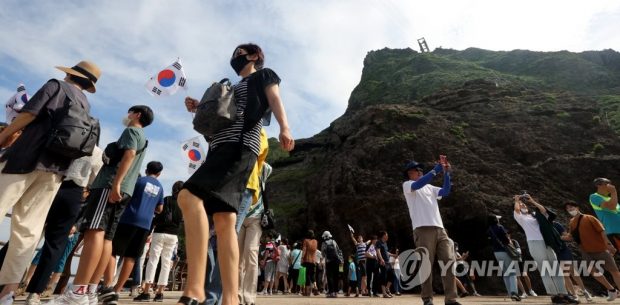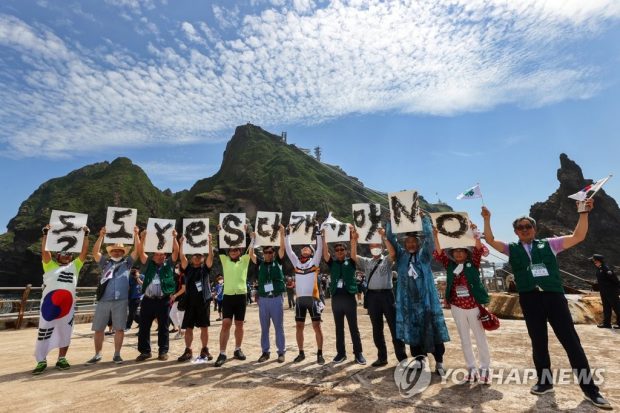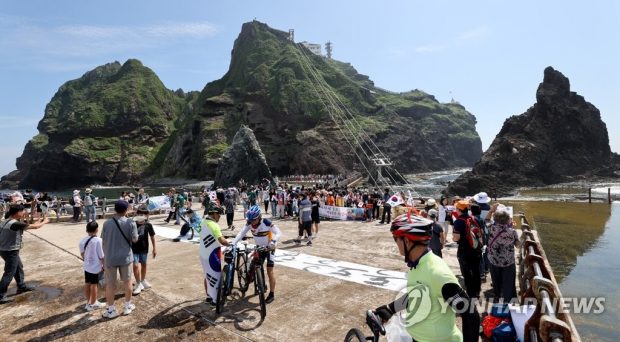
South Koreans celebrate Liberation Day 75th anniversary on Dakdo islets

DOKDO: Nearly 2,000 South Koreans have visited South Korea’s easternmost islets of Dokdo, located 220 kilometers east of the Korean Peninsula, as the country celebrated the 75th anniversary of Liberation Day.
According to Yonhap news agency, six boats on Thursday carried the South Korean tourists who wanted to set foot on Dokdo soil to mark their country’s independence.
Among the tourists were officials from Yeongju City, North Gyeongsang Province, it added.
During the visit, Mayor Jang Wook-hyeon and officials encouraged the Dokdo Coast Guard.
“We have come here to cheer on our Coast Guard who are working to protect our islets in Dokdo day and night,” Jang was quoted as saying.
Several events were organized at the boarding dock to celebrate Liberation Day.
People displayed their love for the historically significant islets and engaged in a photo shoot with placards that highlighted South Korea’s sovereignty over them.
About 40 people residing on Dokdo, mainly police officers stationed at the islets’ watch post.
South Korea has maintained effective control of the islets with a small police detachment since their liberation from Japanese colonial rule in 1945. Japan has persistently laid claim to Dokdo, drawing strong condemnation from the Seoul government.

Dokdo, around 90 kilometers from Ulleung, the nearest populated island, has a combined size of 190,000 square meters.
According to Yonhap, the earliest record goes back to 512, when Ulleung and Dokdo were subjugated by the Silla Dynasty (57 B.C.- A.D. 935).
Around 200,000 people visit Dokdo every year, but reaching the rocky islets is often challenging due to strong tides, making access possible only under clear weather conditions.
The islets are home to hundreds of rare plants and animals, and they bear the nickname “hometown of birds” in South Korea.
Scientists have discovered tens of different plants on Dokdo, along with various species of migrant birds. The biodiversity gets even richer underwater, with nearly 400 species of marine life being observed so far.
“Dokdo is like an oasis in a desert. It stands in the center of the East Sea, providing a home for various organisms,” said Min Won-gi, a researcher of marine biology at the Korea Institute of Ocean Science and Technology (KIOST), Yonhap reported.
Although its isolated nature has helped Dokdo to sustain this rich environment for hundreds of years, researchers have recently been on high alert as the islets may become the latest victims of global warming.
“Recently, the number of days in which the surface water temperature escalates beyond 20 degrees has increased,” said Lim Jang-geun, another researcher at the Ulleung-based KIOST lab.
Experts say South Korea needs to keep close track of the changes in Dokdo’s marine environment in order to maintain its biodiversity.
“For example, we are discovering tropical fish in waters near Ulleung and Dokdo, along with an unusual increase in the number of sea urchins,” Lim added. “We need to keep a watchful eye on how this will affect the entire ecosystem.”

Sea urchins are considered major threats as they consume marine plants, leading to the desertification underwater.
“Marine plants and creatures are very sensitive to changes in the water temperature. However, sea urchins, which quickly adapt to such changes, are reproducing quickly near Dokdo,” added Kim Seong-su, a researcher at the Korea Marine Environment Management Corporation.
Over the past few years, the Ministry of Oceans and Fisheries and related organizations have been making efforts to curb the number of sea urchins near Dokdo, eliminating a whopping 7.3 tons of them in 2018.
“We are currently trying to find out why the number of sea urchins has increased. It could be caused by global warming or because they have no predators,” Min added.
Divers are also cleaning the surface of underwater rocks to help marine plants settle.
“Although we need to make more efforts, we can already observe that sea plants have returned to their habitat in some areas,” said Kim, who has visited Dokdo more than 50 times.
The ministry also released 10,000 striped beakfish, major predators of sea urchins, last year. The same number of fish will be released by the end of this year as well.


